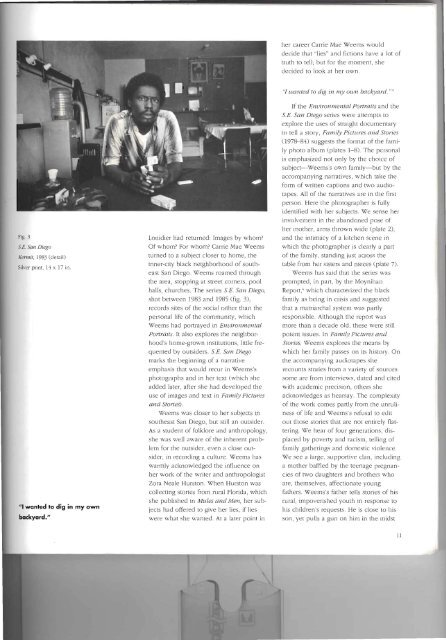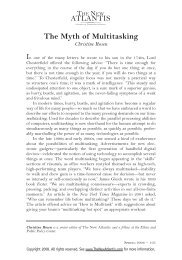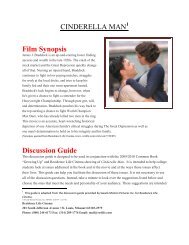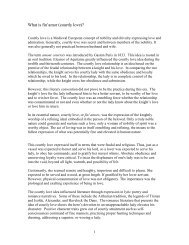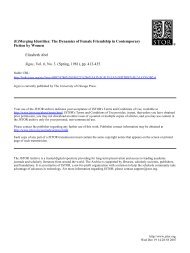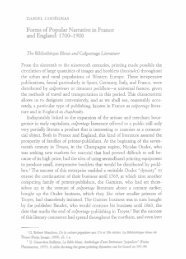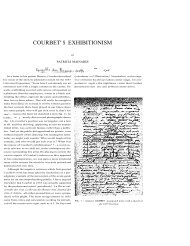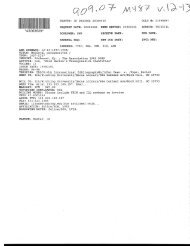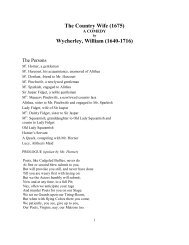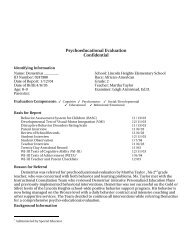CARRIE MAE WEEMS - People Search Directory
CARRIE MAE WEEMS - People Search Directory
CARRIE MAE WEEMS - People Search Directory
You also want an ePaper? Increase the reach of your titles
YUMPU automatically turns print PDFs into web optimized ePapers that Google loves.
her career Carrie Mae Weems would<br />
decide that "Jies" and fictions have a lot of<br />
truth to tell; but for the moment, she<br />
decided to look at her own.<br />
Fig. .l<br />
Sf. Scm Diego<br />
Kenllit, 1983 (detail)<br />
Silver print, 14 x 17 in.<br />
"I wanted to dig in my own<br />
backyard."<br />
Lonidier had returned: Images by whom?<br />
Of whom? For whom? Carrie Mae Weems<br />
turned to a subject closer to home, the<br />
inner-city black neighborhood of southeast<br />
San Diego. Weem~ roamed through<br />
the area, stopping at street corners, pool<br />
halls, churches. The series S.E. San Diego,<br />
shot between 1983 and 1985 (fig. 3),<br />
records sites of the social rather than the<br />
personal life of the community, which<br />
Weems had portrayed in Environmental<br />
Portraits. It aJso explores the neighborhood's<br />
home-grown institutions, little frequented<br />
by outsiders. SF San Diego<br />
marks the beginning of a narrative<br />
emphasis that would recur in Weems's<br />
photographs and in her text (which she<br />
added later, after she had developed the<br />
use of images and text in Family Pictures<br />
and Stories).<br />
Weems was closer to her subjects in<br />
southeast San Diego, but still an outsicler.<br />
As a student of folklore and anthropology,<br />
she was welJ aware of the inherent problem<br />
for the outsider, even a close outsider,<br />
in recorcling a cuJture Weems has<br />
warmly acknowledged the int1uence on<br />
her work of the writer and anthropologist<br />
Zora Neale Hurston. When Hurston was<br />
coUecting stories from rural Florida, which<br />
she published in Mules and Men, her subjects<br />
had offered to give her lies, if lies<br />
were what she wanted. At a later point in<br />
"J wanted to dig in my own backyard. '"<br />
If the Environmental Portraits and the<br />
SF San Diego series were attempts to<br />
explore the uses of straight documentary<br />
to teU a story, Family Pictures and Stories<br />
0978--84) suggests the format of the family<br />
photo album (plates 1-8) The personal<br />
is emphasized not only by the choice of<br />
subject-Weems'S own family-but by the<br />
accompanying narratives, which take the<br />
form of written captions and two audiota<br />
pes. All of the narratives are in the first<br />
person. Here the photographer is fully<br />
identified with her subjects. We sense her<br />
involvement in the abandoned po~e of<br />
her mother, arms thrown wide (plate 2),<br />
and the intimacy of a kitchen scene in<br />
which the photographer is clearly a part<br />
of the family, standing just across the<br />
table from her sisters and nieces (plate 7).<br />
Weems has said that the series was<br />
prompted, in part, by the lvIoynihan<br />
Report," which characterized the black<br />
family as being in crisis and suggested<br />
that a matriarchal system was partly<br />
responsible. Although the report was<br />
more than a decade old. these were still<br />
potent issues. In Family Pictures and<br />
Stories, Weems explores the means by<br />
which her family passes on its history. On<br />
the accompanying audiotapes she<br />
recounts stories from a variety of sources:<br />
some are from interviews, dated and cited<br />
with academic precision, others she<br />
acknowledges as hearsay. The complexity<br />
of the work comes partly from the unruliness<br />
of life and Weems's refusal to edit<br />
out those stories that are nor entirely flattering.<br />
We hear of four generations, displaced<br />
by povelty and racism, telling of<br />
family gatherings and domestic violence.<br />
We see a large, supportive clan, including<br />
a mother baffled by [he teenage pregnancies<br />
of two daughters and brothers who<br />
are, themselves, affectionate young<br />
fathers. Weems's father tells srories of his<br />
rural, impoverished youth in response to<br />
his children's requests. He is close to his<br />
son, yet puJls a gun on him in the midst<br />
11


